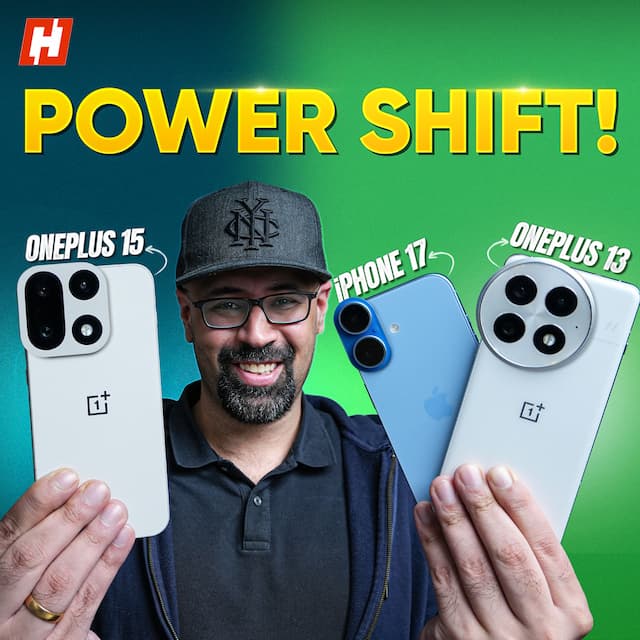OnePlus 15 Review: Downgrade or strategy? (ft iPhone 17 & OnePlus 13)

| Category | Key Specification |
| Processor | Snapdragon 8 Elite Gen 5 Chipset |
| Display | 6.78-inch, AMOLED, 165Hz |
| Software | OxygenOS 16/Android 16 |
| RAM + Storage | Upto 16GB RAM/512GB Storage |
| Rear Cameras | 50MP main + 50MP UW + 50MP Tele |
| Selfie Camera | 32MP |
| Battery + Charging | 7300mAh + 120W wired + 50W wireless |
- First phone with 165Hz LTPO AMOLED
- Sharp new design with Sandstorm finish
- Ultra-slim, perfectly even bezels
- True 165 FPS gaming support
- Nano-ceramic frame is lighter and tougher
- Huge 7,300mAh battery with 120W charging
- OxygenOS 16 feels faster and smoother
- Display resolution drops from QHD+ to 1.5K
- Only games can hit 165Hz; UI stays at 120Hz
- Cameras uses smaller sensors across all lenses
- Runs slightly warm under heavy load
It feels like OnePlus hit the reset button for the OnePlus 15and you only really see the full picture when you place it next to the OnePlus 13 and the iPhone 17. It’s an unexpected trio, but a really telling one.
This year, OnePlus has made some gutsy choices. No partnership with Hasselblad to tune the cameras, a lower-res display, smaller camera sensors, and even softer haptics. On paper, it sure sounds like a downgrade. But is it though?
Apple, on the other hand, went the opposite direction with the iPhone 17, adding that smooth 120Hz ProMotion screen, a 48MP ultrawide, and 256GB base storage.
And the OnePlus 13 still holds up as that reliable, balanced flagship. So is the OnePlus 15 actually a step back, or is something smarter happening here? Let’s dig in.
OnePlus 15 Design and Build: A Sharper Style With a Premium Finish
The OnePlus 15 immediately feels different the moment you pick it up. The whole design has been cleaned up and sharpened, giving it a more industrial and grown-up personality. The new Sandstorm finish really adds to that vibe. It has a matte, slightly gritty texture that not only feels secure but also refuses to show fingerprints. And even though the display is bigger this year, the phone somehow ends up feeling slimmer and lighter in the hand.
This Sandstorm version uses a glass-fibre back, while the black and violet models use either Gorilla Glass 7i or Crystal Shield Glass. So your colour choice actually changes how the phone feels. It’s a small detail, but one you notice immediately.
Day-to-day use is surprisingly comfortable. The 6.78-inch size doesn’t make it awkward or heavy, and the flat back helps the phone sit nicely in your palm. If I’m honest, I still have a soft spot for the frosted matte finish on the OnePlus 13 because it had that smooth, premium touch. But the new finish definitely has its own charm.
Visually, the biggest change is the camera layout. OnePlus has finally moved away from its iconic circular module and replaced it with a square-shaped island. It looks cleaner, more intentional, and very much in line with the direction Oppo has taken with its recent designs.
The frame also gets a major upgrade. Instead of aluminium, the OnePlus 15 uses a nano-ceramic metal chassis. It’s aerospace-grade, lighter than titanium by about 26 percent, and a lot more wear-resistant. In the hand, it feels solid, slightly cool, and almost ceramic-like. It’s one of those details that quietly makes the phone feel more premium.
Durability also gets a noticeable bump. The phone carries IP66, IP68, IP69, and even IP69K ratings, meaning it can handle dust, water, and high-pressure sprays better than its rivals. The OnePlus 13 and iPhone 17 are both well-protected with their IP ratings, but the OnePlus 15 clearly goes a step further.
That said, the OnePlus 13 still feels fantastic with its smooth curves and iconic alert slider. And the iPhone 17 remains the smallest and most balanced option of the three, with that familiar Apple feel.
OnePlus 15 Display: A 165Hz Screen With an Unexpected Twist
I have mixed feelings about the OnePlus 15’s display, to be honest. On one hand, it’s the first phone to ship with a 165Hz LTPO AMOLED panel, which sounds impressive.
But then you notice the twist: the resolution has dropped from the OnePlus 13’s QHD+ to a 1.5K panel. And while the hardware can technically hit that full 165Hz refresh rate, you only get it in supported games. The everyday UI, scrolling, and animations still top out at 120Hz.
If you compare numbers on a spec sheet, the OnePlus 13 definitely looks stronger. It has the sharper QHD+ display and a massive 4,500-nit peak brightness. But the OnePlus 15 makes up ground with better HDR tone mapping and Ultra HDR playback, which give you more depth and richer colour in real content.
And those bezels are insanely thin. They’re almost perfectly symmetrical, and the phone looks gorgeous whether the screen is off or you’re watching something edge-to-edge.
Meanwhile, the iPhone 17 finally brings 120Hz to the standard model. Its 3,000-nit peak brightness makes it super easy to use outdoors, and although it’s the smallest at 6.3 inches, it feels the most polished for everyday use.
OnePlus 15 Performance: Elite Power Meets True 165 FPS Gameplay
The OnePlus 15 doesn’t waste any time showing what it’s made for: performance and gaming. Once you start pushing it, you can feel the new Tri-Chip setup doing its thing.
The Snapdragon 8 Elite Gen 5 handles the main grunt work, but the magic comes from the two supporting chips. The 330Hz Touch Response Chip makes every gesture feel quicker than your fingers expect, and the Wi-Fi G2 chip keeps online play steady even when the network around you dips. Together, they give the phone this snappy, always-awake personality that’s hard to miss.
You see the impact in benchmarks too. The OnePlus 15 pulls noticeably ahead of the OnePlus 13 in AnTuTu by roughly 20 per cent and edges out both the 13 and iPhone 17 in Geekbench’s CPU scores. It can warm up during demanding tasks, but the important thing is that it doesn’t stumble. There’s barely any throttling, so performance stays consistent instead of suddenly tanking during long sessions.
Gaming is where things get wild. The OnePlus 15 can push actual native 165 FPS in supported games, including Call of Duty Mobile. This isn’t some frame-boost gimmick. The phone’s 165Hz panel and OP FPS Max tech let the game render and display every one of those frames in real time.
We tried it for over half an hour, and the frame rate didn’t budge. Most casual users will notice it as “extra smooth,” but if you play competitively, the difference in responsiveness is obvious. No other phone right now is delivering true 165 FPS gameplay like this.
Of course, the OnePlus 13 and iPhone 17 still offer great gaming experiences. Both can run 120 FPS titles cleanly, and Apple’s A19 chip remains the only smartphone processor capable of handling proper console-level games.
But if your top priority is raw gaming power, the OnePlus 15 takes the crown without much debate.
RAM and storage also get a tidy upgrade. The 16GB version uses faster LPDDR5X Ultra+ RAM, and both RAM options come with UFS 4.1 storage. The OnePlus 13 technically goes higher with its 24GB variant, but it uses regular LPDDR5X and slightly slower UFS 4.0. The iPhone 17 stays at 8GB, though Apple’s optimisation keeps it feeling smooth in daily use. And all three start with a healthy 256GB of base storage.
OnePlus 15 Battery and Charging: A Massive Cell Backed by 120W Speed
The battery setup on the OnePlus 15 is honestly one of its biggest flexes. You get a huge 7,300mAh cell, which is massive for a flagship, and it shows in daily use. Charging is just as impressive. With 120W wired charging, the phone jumps from zero to halfway in about seventeen minutes and reaches a full charge in roughly forty. There’s also 50W wireless charging, which makes quick top-ups effortless.
The OnePlus 13 still puts up a solid fight. Its 6,000mAh battery and 100W charging combo hold up well, and the same 50W wireless charging means it easily lasts more than a day.
The iPhone 17 might sound tiny at 3,692mAh, but Apple squeezes a lot out of it. Thanks to the A19 chip and iOS efficiency, battery life feels stronger than the numbers suggest. It's 40W charging now gets you to fifty percent in twenty minutes and a full tank in about ninety.
OnePlus 15 Camera System: A Shift to Processing Power Over Pure Hardware
The camera system is where you can really tell OnePlus has changed its priorities this year. If you’re comparing pure hardware, the OnePlus 15 doesn’t look as stacked as the OnePlus 13. The main camera moves from the larger 1/1.4-inch Sony LYT808 to a smaller 1/1.56-inch IMX906. The ultrawide sensor is now an OmniVision OV50D, and the telephoto switches to Samsung’s JN5 instead of the chunkier IMX882. So yes, on paper, the hardware feels like a step down.
The Hasselblad branding is also gone. OnePlus is now relying entirely on its own DetailMax Engine for colour and computational processing. The results are still sharp, and there’s plenty of detail, but photos tend to be a little more saturated and skin tones can come out warmer than ideal. The interesting twist is that video performance actually gets a boost. You have 10-bit Log, Dolby Vision HDR, 4K at 120 FPS, and even 8K at 30 FPS, which gives the phone a surprisingly strong video toolkit despite the smaller sensors.
The OnePlus 13 still takes the lead if photography is your main priority. Its triple 50MP setup with bigger sensors and Hasselblad tuning produces more natural colours and handles low light better.
Then you have the iPhone 17, which sticks to two 48MP cameras but still dominates through computational photography. Apple continues to nail consistent colours, great dynamic range, reliable night performance, and the smoothest video in the business.
If you want a camera that just works every single time with minimal effort, the iPhone 17 remains the safest bet. The OnePlus 15, meanwhile, feels more like a solid all-rounder with a serious focus on video rather than pure photography.
OnePlus 15 Audio and Haptics: Better Speakers, But a Softer Taptic Punch
This is where the little everyday extras start to show. The OnePlus 15 gets noticeably louder and more even stereo speakers, but the haptic feedback feels gentler compared to last year. And yes, the classic alert slider is gone. In its place is the new Plus Key, which you can customise for quick shortcuts. It’s handy, but it doesn’t bring the same personality.
The OnePlus 13 still offers that familiar, punchy haptic feel and the much-loved slider. Meanwhile, the iPhone 17 continues to be the most refined of the bunch, with excellent haptics, rich audio, and Apple’s usual attention to detail.
OnePlus 15 Software: A More Polished and More Intelligent Experience
The OnePlus 15 runs OxygenOS 16 on top of Android 16, and this version already feels like one of the best OS’ out there. We’ve used it earlier on the OnePlus 13S, and the difference is obvious. The UI feels quicker, animations feel tighter, and there’s a lot more freedom to tweak the look and behaviour of the system. The new AI features are the biggest highlight, and they actually feel useful instead of gimmicky.
Mind Space continues to be the standout. It organises screenshots and notes automatically, and now that it works with Google Gemini, you can dig through your personal data almost instantly. The gallery also gets AI editing tools that make quick fixes really simple.
The OnePlus 13 is still on OxygenOS 15 for now, though the OxygenOS 16 rollout has already begun. On the iPhone 17 side, iOS 26 brings Apple Intelligence features for writing and image generation, but they don’t feel as flexible as OnePlus’s approach.
Apple still wins on longevity. The iPhone 17 gets six to seven years of updates, while OnePlus offers four.
OnePlus 15, iPhone 17 or OnePlus 13, Which One Comes Out On Top?
So which phone actually deserves your money?
The OnePlus 13 is still that steady, reliable choice. It nails the basics, has strong cameras, a comfortable design, and gives you that familiar OnePlus feel people trust. The iPhone 17 is the safest pick if you’re tied into Apple’s ecosystem. It’s the most polished overall, performs consistently well, and offers unbeatable long-term support.
The OnePlus 15, though, is the one that surprises you.
It may look like a downgrade when you read the spec sheet, but in real use it feels like the most balanced of the three.
You get excellent performance, a huge battery, extremely fast charging, and a display capable of 165 FPS gaming. If the camera had kept up with last year’s hardware, this would be an easy A+. Even as it stands, it earns a solid A and shows exactly where OnePlus wants to go next.



